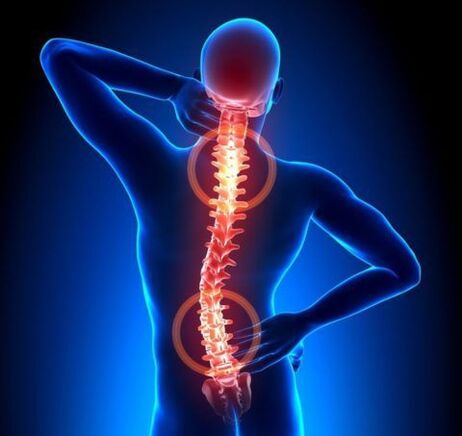
Many people aged between 30 and 35 complain about back pain.The cause of these pains can be the disease of the spine.Osteocondrosis is a disease that occurs in middle -aged people, but is more often detected in patients after 40 years.
Osteocondrosis: What is this disease and what is its danger?
This term means a dystrophic process of cartilage and bone tissue subject.In modern medical practice, osteochondrosis is called degenerative dyeing disease of the spine and intervertebral discs that play the role of the impact absorber.The danger of the disease is that the disc affected is almost impossible to restore and without adequate treatment, disability is possible.
Is osteocondrosis a common disease?The statistics are not happy.About 85% of the population in the world suffers from this disease.
This disease is the most common form among all the diseases that affect the spine.And according to the prevalence, it is immediately after diseases of the cardiovascular system.
The essence of the disease
So, osteochondrosis - What is it?This is a chronic disease that affects the joints, very often the spine.
The spinal column consists of 24 vertebrae.Between the two vertebrae there is a disc, whose purpose is the softening and depreciation of the loads.
In normal conditions, the disc is quite elastic and can resist significant loads.At the center of the disc there is a nucleus of the pulp with a lot of water.For some reason, the core loses its hydrophilic properties.
Consequently, the delaying disk decreases in height and deformation.In the following stages, the growth of bone tissue occurs with the formation of growth - osteophytes that compress the peripheral nerves and the spinal cord.This is what is the osteochondosis of the spine.
The causes of the pathology
Despite the fact that osteochondosis is a fairly common disease, the reasons why the pathology develops are not fully established.

The main factors are considered:
- excessive load on the spine;
- injuries;
- Professional damage - weight lifting or prolonged work in an uncomfortable and immobile pose;
- Excess body weight;
- inheritance;
- Violation of posture.
Osteocondrosis develops up to one degree or another in almost all the people of the elderly and is one of the body aging processes.
Phase, forms and symptoms of the development of the disease
Experts distinguish 4 phases of the disease:
- 1st stadium- by moving the core of the disk on the edge;
- Phase 2- the occurrence of cracks in the cartilage wheels and the instability of the vertebral section;
- Phase 3- a complete break of the disc with the loss of the nucleus in the stem of the spine, while the roots of the spinal cord are possible;
- 4th stadium- approximate changes not only in the intervertebral disc, but also in the surrounding tissues.
The main symptom of the disease is pain.It can be acute with high intensity or stupid moderate manifestation.
In addition to pain, there are:
- painful tension of the back muscles;
- numbness of the skin on the arms and legs;
- limitation of the volume of movements;
- weakness in the muscles of the limbs;
- thinning of the arms and legs;
- Sudden dizziness.
These are general manifestations for all forms of pathology.Depending on the spine in which the changes are located, three forms of the disease are distinguished with characteristic symptoms.
Table no.1. Forms of osteochondrosis and their intrinsic symptoms:
| Form of the disease | Symptoms |
| Osteochondrosis in the neck | The changes in this department lead to the push of the blood vessels and the compromise of the microcirculation.For this reason, a person has constant dizziness.Sometimes this leads to fainting.There are noise in the ears and tremoli of colored spots in front of the eyes. |
| Osteochondrosis in the thoracic vertebrae | With this form of illness, an acute chest pain is observed.The disease can cause the progression of intercostal neuralgia and aggravate the course of heart diseases. |
| Osteochondrosis in the lumbar region | The pathology in the lower part of the back is manifested by pain in the gluteal region, a decrease in the tone of the IKR.A complication can be the Radicolite, which is accompanied by pain that spreads throughout the leg. |
Due to the pathology of the vertebral discs, a large number of disorders in the body occurs: pinch of nerves, swelling, circulatory violation and fibrosis of the surrounding tissues.These changes cause a variety of symptoms, which complicates the diagnosis and prescribe appropriate treatment without an examination carefully.
Clinical events
The symptoms of the disease depend on where the lesion is mainly found.In the following sections, we consider the characteristic signs of each variety of the disease.
The Cervical Department
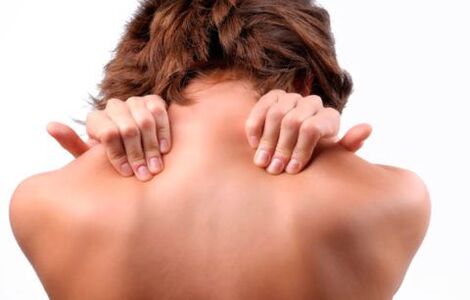
The main symptoms of damage to the cervical column include:
- discomfort, sore in the neck and shoulders;
- Muscle hypotonus;
- increase in sweating;
- numbness of the fingers;
- violation of the coordination of movements;
- headache, dizziness;
- Problems with hearing and vision;
- Hypertension.
With the progression of the disease and damage to the arteries and neighboring nerves, one of the following syndromes can develop:
- vertebral artery;
- cardiac;
- hypertension;
- root;
- Cervical migraine.
The violation of the blood circulation in the vertebral artery and this hypoxia of the brain tissues are the dangerous consequences of the osteocondrosis.
This syndrome manifests itself:
- Periodic system/dizziness;
- weakening of vision;
- Loss of partial or complete hearing;
- Sometimes - fainting.
Important!The neurological manifestations of the osteochondosis of the spine must often differentiate themselves with the cerebral atherosclerosis, depth and other pathologies.
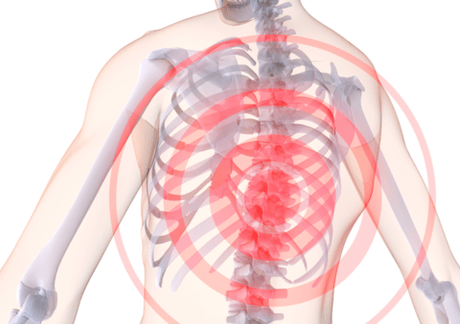
Thoracic region
Compared to other forms of the disease, thoracic osteochondrosis manifests itself less pronounced.
Among its symptoms:
- chest pain, increasing at night or prolonged in a position;
- discomfort, a feeling of squeezing between the shoulder blades;
- Strengthen pain during deep breathing.
If the disease is not treated, it advances, causing damage to the vicinity and nerves located nearby.
The signs of the development of complications of the osteochondosis of the spine of this location can be:
- Numbness of the skin in some areas, a feeling of creeping "goosebumps";
- Itching skin, burning;
- cooling of the limbs;
- fragility of the nails;
- Pronounced dry skin;
- pain along the esophagus and the pharynx;
- Gastrointestinal tract disorders.
Furthermore, the thoracic location of the disease is characterized by two specific symptoms: Dorsago and Dorsalgia.
Dorsago is a sudden, acute and very intense chest pain, a "thoracic round".It can occur with prolonged in the same position, monotonous work.
Be careful!During the breast fillet, pain is so serious that patients are afraid even to make extra inhalation.
Dorsalgia is less intense, but monotonous painful sensations that can last up to 2-3 weeks.They intensify with deep breathing, inclinations.
Lumbar department
The osteochondrosis of the lower part of the spine, namely the lumbar, occupies a prominent position on the prevalence.
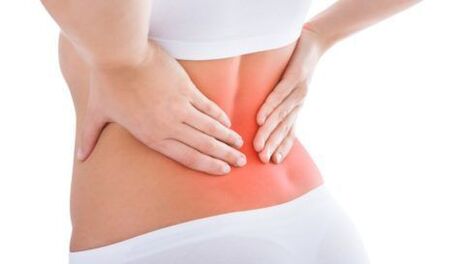
Among its characteristic symptoms:
- Doll, more often painful back pain, radiating in the leg;
- discomfort, intensifying when changing the position of the body, sneezing, cough, trying to lift weights;
- constant muscle spasm in the lower back;
- Lights in the lower back;
- compromised sensitivity on buttocks of buttocks, hips, legs, feet;
- a feeling of crawling of goosebumps in the lower limbs;
- Dry, skin peeling.
The Sacral Department
The osteochondrosis of the sacred spine is extremely rare in an isolated way and is usually a "continuation" of the lower lumbar damage.
This explains the characteristics of its symptoms:
- Back pain, as well as in the sealing nerve;
- "Refuges" acute through the entire leg;
- an unpleasant feeling of discomfort in the back of the thigh;
- numbness of the lower limb;
- Unstable paresis and symptoms of compromised motor activity.
Important!The osteochondrosis of the lower column of the spine can lead to as dangerous complications as the blood supply compromised to the spinal cord and compression myelopathy.

Common osteochondrosis
A common form or osteochondosis of all parts of the spine is the most serious version of the pathology.Due to the vastness of the defeat, its picture can be extremely diversified and include almost all the symptoms described above.
Diagnostic methods
The appearance of any complaints indicated above requires an appeal to a medical institution: the patient must examine the patient.The diagnosis of osteochondrosis should be complex and very in -depth.
Standard instruction includes the following phases:
- Collection of complaints and anamnesis.
- Clinical inspection.
- X -Ray exam.
- Modern methods (CT, MRI).
Conduct a conversation with the patient, the doctor should discover:
- that disturbs the patient;
- What is the place of the most pronounced unpleasant sensations;
- What is their intensity and duration;
- which causes their strengthening;
- which helps to cope with pain.
Important!Make sure to tell the doctor how long you are worried about such complaints and if you have received a treatment previously.

During a clinical inspection, the specialist evaluates:
- the position of the patient's body, his pace, the volume of active and passive movements;
- the presence of leather defects, redness, peeling;
- symmetry of healthy and sick parts of the body;
- the presence of muscle spasm;
- the area of pain irradiation;
- The presence of pain, temperature and other types of sensitivity.
During the X -ray, each spine for a better view is designed individually.The images are carried out live, side and (according to the indications) of two oblique projections.To evaluate the stadium and the severity of the degenerative distance changes, the classification of X -rays of osteochondosis of the ostebral column of the zeaker is used.
Table: X -Ray phase of osteochondosis of the spine:
| Stage | Description |
| I (+) | Expressed changes in Lordosis in a small number of segments |
| II (++) |
|
| III (+++) | Expressed changes, a significant narrowing of intervertebral holes |
| IV (++++) | Significant reduction of intervertebral holes, massive exostosis, often irreversible changes |
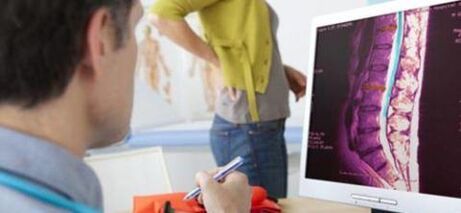
With an insufficient information content of the R-Picture, the patient may be prescribed more modern-ct tests (targeted images of one or more segments of the spinal column) and MRI (visual diagnostic method based on the properties of electromagnetic radiation).
Treatment
First of all, the doctor explains to the patient what osteochondosis is and how to treat him.It speaks of a series of measures that must be performed for a long period.
The therapy of the disease is carried out taking into account the phase.In the initial period of the disease, massage, physiotherapy, physiotherapy exercises are indicated.But as the dystrophic process advances, various orthopedic devices should be used to immobilize the spine.Pharmacological treatment is also necessary.
The surgery is indicated with complications and with the ineffectiveness of the conservative treatment.
Medicines
The most important tasks of pharmacological treatment are the relief of pain, eliminating the inflammation of the nerve roots, restoring the structure of the cartilage, improving blood circulation and nutrition, stopping the development of the pathology.There are several groups of drugs that can be prescribed in this case.
In pharmacies, they are represented in various forms and in a wide variety.The price of medicines can be different and you can always choose the most convenient.
Table no.2. Doctors used in the conservative therapy of osteochondrosis:
| Pharmacological group | Therapeutic effect | Instructions for use |
| Condroprotectors | It slows down the cartilage degeneration processes, contributes to its restoration. | Take 1 capsule for a month.If necessary, the course of treatment is repeated. |
| Fans | It has an anesthetic effect, reduces the inflammatory process. | Take a table for pain.With severe pain, intramuscular injections of the drug are used. |
| Vitamins of Group B. | It improves the conductivity of the nervous impulse, restores the microcirculation in the area of the cartilage concerned. | The course of treatment with intramuscular injections is performed. |
| Musorelassant | Relax muscles, relieves tension, facilitates pain. | Take one tablet 2 times a day. |
The drugs are prescribed according to the doctor's testimony.The car -mediation can be ineffective and in some cases even damage.
Physiotherapy for osteochondrosis
What to do with osteochondrosis, with the exception of drugs, to accelerate recovery?One of the most effective methods for the treatment of this disease is physiotherapy.
Its advantage is a selective effect on the focus of the disease.Physiotherapy contributions to reduce pain, the elimination of inflammation and increase general immunity.With their help, the muscles relax, metabolic processes and blood circulation are normalized.
For osteochondrosis, they are successfully used:
- magnetotherapy;
- laser therapy;
- shock wave therapy;
- quartz;
- electrophoresis;
- The effect of low -frequency electric currents.
Physiotherapy does not perform if the patient is in serious condition, with an exacerbation of the disease, oncological diseases and mental disorders.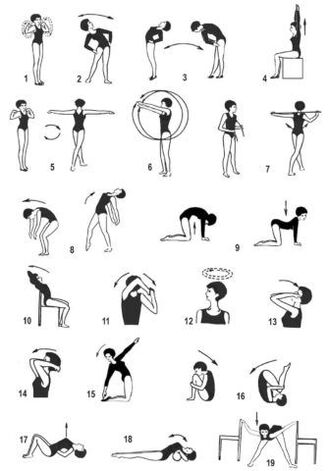 In other cases, physiotherapy has a beneficial effect on the recovery process, improves the effect of drugs, which reduces their dosage.
In other cases, physiotherapy has a beneficial effect on the recovery process, improves the effect of drugs, which reduces their dosage.
Medical physical education
Physical education lessons are prohibited in the acute period of the disease.After eliminating this period, the doctor prescribes therapeutic exercises, which develops together with the instructor individually for each patient.
With the help of the exercises, the muscle corset is strengthened, which prevents the curvature of the spine and allows you to properly and uniformly distribute the load on the vertebrae.With regular physical effort, medicinal substances penetrate the spine in higher concentrations than their absence.
It is necessary to engage in the guidance of an expert instructor and carefully monitor their conditions.With discomfort and severe pain, the exercise should be stopped.
Prevention
Knowing what osteochondrosis and its consequences is, it will be useful to think about prevention.
The preventive measures are quite simple, they are easy to perform for all those who care about their health:
- Injury prevention;
- Regular physical training (swimming is very useful);
- maintain a normal weight;
- Do not load the spine;
- monitor the correctness of the posture;
- Don't be in a position for a long time;
- Avoid sudden movements when lifting weights.
When you fulfill these rules, the remission period will be long.
Osteocondrosis is a rather serious disease.But with the timely research of a doctor and adequate treatment, it is possible to stop its destructive effect.
Questions to the doctor
Neck pain
Hi, tell me please.I am 24 years old.Over the past two months, neck pain, the back of the head (sometimes it is still given to whiskey, eyes).Also known a strong creaking in the neck, tingling and numbness of the hands, language and sky.
I suspect osteochondrosis, because both the mother and the grandmother of youth are tormented with similar symptoms.Where to start the exam?And another question: can I go to Aerobics?
Create a R-Scheme (CT) and Doppler shop of the heads of the head and neck.You have probably developed the vertebral artery syndrome against the background of the cervical osteocondrosis.A further plan for diagnosis and treatment can only be drawn up after obtaining the results of these tests.
It is better not to visit the aerobics.
Lumbar osteochondrosis
For seven years I have been tormented with the lower back, the exacerbation of the osteocondrosis is almost every 2-3 months.Injections and tablets help for a short period, so the pain returns.I work as a postman, it becomes more difficult.Did I put invalidity?
HI!The decision on the invalidity group prize is taken from the AiU on the basis of a global study of your situation.First you need to contact the therapist and undergo an exam.
As a rule, with lumbar osteochondrosis, a group of disability is not shown.His prize is possible with the development of complications (protrusions, intervertebral hernias, etc.).But, once again, I repeat, everything is individual here.


























